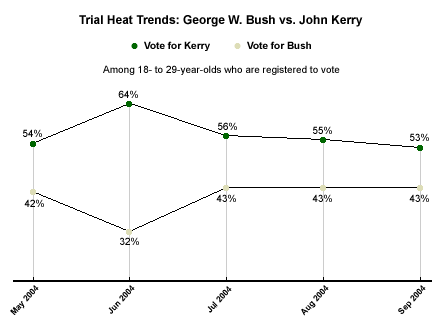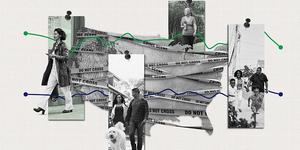This election season, Americans across the nation can catch any number of campaigns on television, newspapers, and Internet sites -- whether it be "Choose or Lose: Twenty Million Loud," "Rock the Vote," or "Two Million More in 2004" -- to encourage and persuade the nation's youth to register and vote in this year's presidential election.
The effectiveness of these ads are unknown, but a review of Gallup polling over the past several months gives some insight into how younger Americans (aged 18 to 29) feel about this year's election*. Gallup finds younger voters currently more likely to support Democratic candidate John Kerry rather than President George W. Bush. Compared with the past two presidential elections, younger Americans also show higher levels of interest in this year's election, higher levels of self-reported voter registration, and higher levels of intention to actually vote. However, these attitudes have increased among all measured age groups and young people's interest levels in the election are still well below the national average.
In order to closely examine the opinions of younger voters in the country, Gallup combined the results of its surveys from May through September on a month-by-month basis. The results are based on three surveys conducted in May, two surveys from June, three polls in July, two in August, and three in September.
Majority of Younger Voters Support Kerry
The May-September aggregate shows that registered voters aged 18 to 29 prefer Kerry to Bush, with Kerry typically leading Bush in this age group by 10 percentage points to 13 percentage points.
In May, 54% of younger voters said they would vote for Kerry, and 42% for Bush. Kerry's support then spiked in June among registered 18- to 29-year-olds, with 64% supporting for Kerry and 32% for Bush. Over the past three months, vote choice among 18- to 29-year-olds has remained quite stable. Most recently, in Gallup's September polling, 53% of registered voters aged 18 to 29 said they would vote for Kerry, while 43% would vote for Bush.

Among all registered voters, younger voters are now nine points higher than average in their support for Kerry, and are now nine points lower than average in their support for Bush.
|
Trial Heat Trends: George W. Bush vs.
John Kerry |
||
|
|
|
|
|
|
Vote for Kerry |
Voter for Bush |
|
|
% |
% |
|
Sep 2004 |
44 |
52 |
|
Aug 2004 |
47 |
48 |
|
Jul 2004 |
49 |
46 |
|
Jun 2004 |
49 |
44 |
|
May 2004 |
49 |
46 |
What does history show about the youth vote? In 1996, Democratic incumbent Bill Clinton led Republican challenger Bob Dole 54% to 30% among this age group, according to Gallup's final pre-election poll, compared with Clinton's 50% to 34% lead over Dole among all voters.
In the 2000 final pre-election poll, young voters were as likely to support Bush as Vice President Al Gore, and in 1992, Clinton only had a small advantage among 18- to 29-year-olds over the elder George Bush, 40% to 37% (Clinton's advantage over Bush among all voters was 43% to 34%).
Although young voters are currently more likely to vote for Kerry than for Bush, and more likely to support the Democratic candidate than in recent elections, several other subgroups are much more likely to support Kerry, including blacks, Democrats, or liberals. Younger voters support Kerry at roughly the same levels as those with a postgraduate education, those who did not graduate high school, those in the lower income levels, those living in the Eastern part of the country, and those with a moderate political ideology.
Voting in This Year's Presidential Election
Interest in the Race
Polling results this year have consistently shown higher levels of interest in this year's presidential election among all adults nationwide than at comparable times in 1996 or 2000. While the increase is evident among all measured age groups, it is higher among 18- to 29-year-olds, who typically exhibit much lower levels of election interest.
Current data based on polls conducted from mid-July through the end of September show that 66% of 18- to 29-year-olds now say they have given quite a lot or some thought to this year's election. This can be compared with 57% on election eve in 2000 and 60% in Gallup's 1996 final pre-election poll. There have been more modest increases in interest over the past three elections among older respondents. Among 30- to 49-year-olds, election interest edged up from 69% to 75%. The results show essentially no change among adults aged 50 to 64 and a seven-point increase among adults aged 65 and older.
Even though interest in the election is up this year among younger Americans, it is still well below the national average. The 2004 data show that 76% of adults nationwide have given quite a lot or some thought to this year's race. The increase among young people may partly be due to their quite low levels to begin with, compared with the already high levels of interest in previous campaigns among older Americans.
Registering to Vote
Gallup trend data show no demonstrable signs of disproportionately higher levels of registration to vote among young people this year, compared with older Americans. The data show that 73% of 18- to 29-year-olds say they are registered to vote this year. In 2000, 65% of 18- to 29-year-olds said they were registered, and 69% said they were registered in 1996. Self-reported voter registration has also increased among older Americans in roughly similar proportions, increasing from 83% to 93% among 30- to 49-year-olds, from 87% to 93% among 50- to 64-year-olds, and from 89% to 93% among those aged 65 and older.
Voter registration among younger Americans remains well below that for other age groups.
Vote Intentions
When asked if they plan to vote in this year's election, Americans in all age groups show an increase in their intentions to vote compared with 2000.
The current data show that 88% of 18- to 29-year-olds say they plan to vote this year, up from 72% in 2000. For those adults aged 30 and older, voter registration was in the mid-80% range in 2000 and above the 90% mark this year.
While intention to vote is higher among 18- to 29-year-olds, younger Americans are again below the national average, which is currently 93%.
*Results are based on telephone interviews with 3,046 national adults, aged 18 and older, conducted Sept. 3-5, Sept. 13-15, and Sept. 24-26, 2004. For results based on the total sample of national adults, one can say with 95% confidence that the margin of sampling error is ±2 percentage points.
Results are based on telephone interviews with 7,590 national adults, aged 18 and older, conducted July 19-21; July 30-Aug. 1; Aug. 9-11; Aug. 23-25; Sept. 3-5; Sept. 13-15; and Sept. 24-26, 2004. For results based on the total sample of national adults, one can say with 95% confidence that the margin of sampling error is ±1 percentage point.
